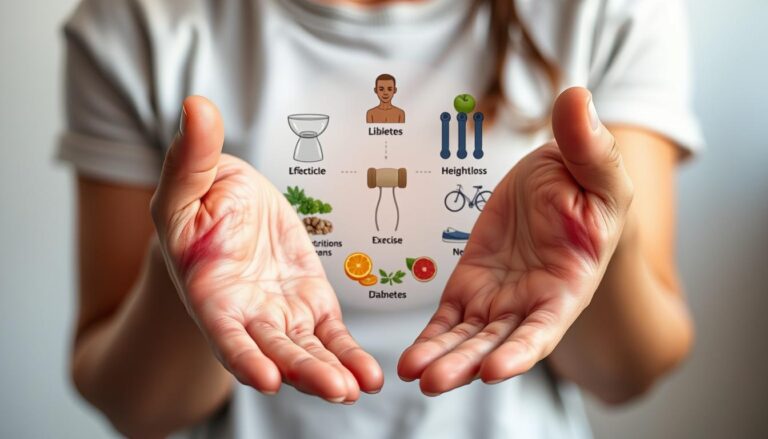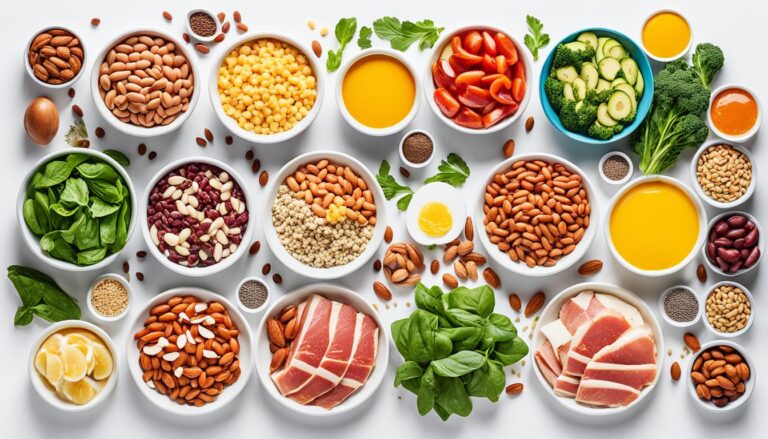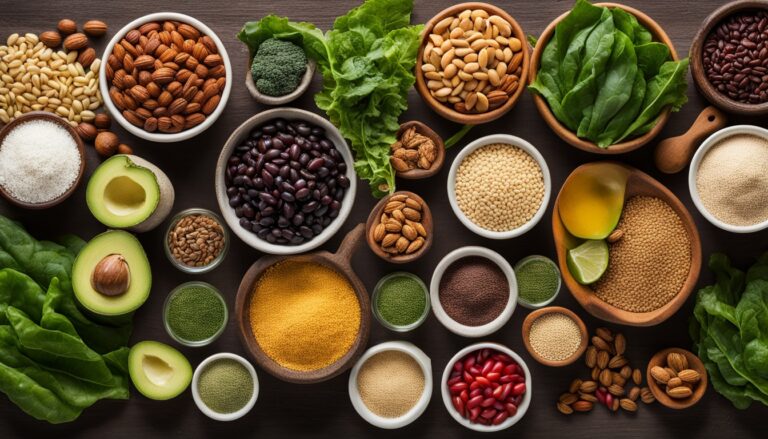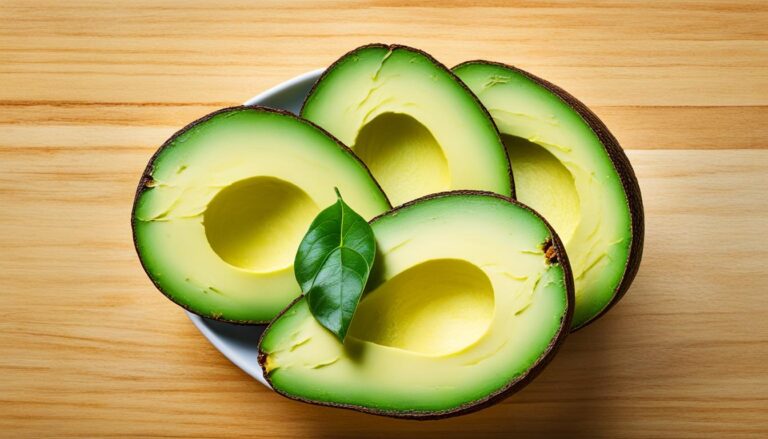Achieving rapid weight loss can feel like an elusive goal, but with an effective diet plan, it’s entirely possible. This article offers a Lose 5kg in 7 Days challenge designed to help you lose weight quickly and safely. With the increasing demand for speedy weight loss solutions in modern society, we’ve crafted a straightforward approach that aligns with the best nutrition science principles and dietary guidelines for Americans.
Our aim is to guide you through a structured plan that emphasizes not only rapid results but also maintaining your health throughout the process. Let’s embark on this journey together, setting you up for success in your weight loss goals!
Key Takeaways
- Rapid weight loss is achievable with a structured plan.
- An effective diet plan minimizes health risks while maximizing results.
- The 7-day challenge is designed for quick, safe weight loss.
- This plan uses trusted nutrition science and dietary guidelines.
- Commitment and consistency are key to achieving your goals.
Introduction to Weight Loss
Embarking on a weight loss journey can be both exciting and challenging, especially when aiming for short-term diet goals like losing 5kg in just 7 days. Understanding the nuances of weight loss education is fundamental to achieving these goals effectively and sustainably.
Why 7 Days?
A 7-day weight loss plan is appealing due to its short-term nature, offering quick results. This condensed time frame can be particularly motivating for individuals eager to jumpstart their weight loss journey. However, it’s important to acknowledge that rapid weight loss may come with its own set of challenges, requiring careful planning and commitment.
The Basics of Weight Loss
The fundamental principles of losing weight revolve around maintaining a calorie deficit, which means consuming fewer calories than your body needs. A balanced approach combining nutrient-rich foods with adequate physical activity is key to a successful weight loss journey. Understanding these basics helps in setting realistic and achievable short-term diet goals.
Setting Realistic Goals
Setting realistic goals is crucial when aiming for substantial weight loss in a short period. According to the American Heart Association, health goals should be specific, manageable, and sustainable. It’s essential to be mindful of the body’s limits and not to push beyond healthy boundaries. Through proper weight loss education, one can set goals that are both ambitious and attainable, ensuring long-term success.
Understanding Caloric Deficit for Weight Loss
Achieving weight loss primarily hinges on understanding and implementing a caloric deficit. Simply put, a caloric deficit occurs when you burn more calories than you consume. This discrepancy forces your body to utilize stored fat for energy, leading to gradual and healthy weight loss. Implementing calorie counting and managing your daily caloric intake effectively form the backbone of any successful weight loss journey.
What is a Caloric Deficit?
A caloric deficit is essential for weight loss. When your daily caloric intake is lower than the amount of calories your body burns, you are in a caloric deficit. This can be achieved through a combination of reducing calorie intake and increasing physical activity. The concept is supported by numerous nutritional science studies, which confirm that a consistent caloric deficit can help shed excess pounds and maintain a healthy weight.
How to Calculate Your Caloric Needs
To effectively create a caloric deficit, it’s crucial to calculate your individual caloric needs. This involves understanding your Basal Metabolic Rate (BMR), which is the number of calories your body needs at rest. Factors such as age, gender, weight, height, and activity level all play a role in determining your BMR. Once you know your BMR, you can use weight loss calculators to compute the total daily caloric requirements.
Here’s a simple table to help you understand the calculation:
| Factor | Details |
|---|---|
| Age | Older individuals typically require fewer calories. |
| Gender | Men generally have higher caloric needs compared to women. |
| Activity Level | More active individuals burn more calories. |
| BMR Calculation | Numerous online tools and health apps can help you calculate your BMR efficiently. |
Once these factors are considered, you can set a target for your daily caloric intake to ensure you are in a caloric deficit. Tracking tools and methods, including apps and food journals, can aid in this calorie-counting process, making it easier to manage and maintain your diet effectively.
You may like to read:Why Healthy Eating Matters Beyond Weight Loss
How to Lose 5kg in 7 Days Diet?
Embarking on an extreme dieting plan may seem like an attractive option for those looking to shed weight quickly. However, it’s essential to consider whether such a rapid strategy aligns with your health goals and safety.
Is It Safe?
Many people wonder about the safety of rapid weight loss. According to clinical studies, losing 5kg in just 7 days can pose health risks if not managed carefully. Extreme dieting can lead to nutrient deficiencies, dehydration, and other health complications. It’s crucial to understand that safety should always come first.
According to the American Dietetic Association, “Quick weight-loss diets are often temporary and may not be sustainable in the long term.”
Consulting with healthcare providers before starting such an aggressive diet is strongly recommended to ensure it does not negatively impact your health.
What to Expect
When engaging in an extreme dieting plan, it’s important to set realistic expectations. The expected results can vary greatly among individuals based on factors such as starting weight, metabolic rate, and adherence to the diet regimen. Some common results include rapid loss of water weight initially, which might be followed by gradual fat loss.

However, readers should be cautious of potential side effects, such as fatigue, irritability, and muscle loss. Sustainable weight loss takes time, and any quick-fix approach should be approached with caution.
Below is a comparative table that outlines the potential benefits and risks associated with rapid weight loss versus a more gradual approach:
| Criteria | Rapid Weight Loss | Gradual Weight Loss |
|---|---|---|
| Initial Results | Quick but often temporary | Slower but more sustainable |
| Health Risks | Higher risk of nutrient deficiencies and dehydration | Lower risk |
| Long-term Success | Typically low | Higher chance of maintenance |
| Overall Well-being | Can be compromised | Generally better |
While extreme dieting may offer quick outcomes, prioritizing rapid weight loss safety and overall health yields more sustainable long-term success.
Creating Your 7-Day Diet Plan
Embarking on a customized diet plan is the first step towards reaching your weight loss goals. Understanding the nuances of meal preparation and serving sizes can significantly simplify this journey.
Meal Planning Basics
Effective meal planning starts with identifying the right foods based on your nutritional needs. Begin by referencing USDA’s ChooseMyPlate guidelines. This foundational step ensures you’re incorporating a balance of fruits, vegetables, whole grains, and lean proteins.
For optimal results, streamline your meal preparation by setting aside time each week. Prepping meals in advance not only saves time but also helps in maintaining portion control. A useful tip is to create a grocery shopping list focused on whole, unprocessed foods, ensuring that your pantry is stocked with the essentials.
Portion Control Tips
Mastering serving sizes is crucial for managing calorie intake without feeling deprived. Incorporate these portion control tips to stay on track:
- Use smaller plates: This visual trick helps in reducing food intake.
- Follow the “plate method”: Allocate half your plate to vegetables, a quarter to protein, and a quarter to grains.
- Measure portions: Utilize measuring cups and digital scales to ensure accuracy.
Research from registered dietitians suggests that this structured approach to diet planning can significantly enhance your success rate.
| Meal Component | Recommended Serving Sizes |
|---|---|
| Vegetables | 2-3 cups per day |
| Fruits | 1.5-2 cups per day |
| Grains | 5-6 ounces per day |
| Protein | 5-6.5 ounces per day |
| Dairy | 3 cups per day |
Choosing the Right Diet Food
When embarking on a weight loss journey, selecting the right diet food is crucial. Personal preferences, lifestyle choices, and health status are all important factors to consider.
Low Carb vs Keto Diet
Understanding the difference between a low-carbohydrate option and a ketogenic regimen can help make an informed choice. A low-carb diet typically limits carbs to around 50-150 grams per day, focusing on proteins and fats for energy. In contrast, a ketogenic regimen drastically reduces carb intake to below 50 grams daily, forcing the body into ketosis.
“The benefits of low carb diets include steady energy levels and decreased appetite, while ketogenic diets may offer faster weight loss but require stricter adherence.”—Harvard T.H. Chan School of Public Health
| Aspect | Low Carb Diet | Keto Diet |
|---|---|---|
| Carb Intake | 50-150 grams/day | Below 50 grams/day |
| Energy Source | Mix of carbs, proteins, and fats | Primarily fats |
| Benefits | Steady energy, reduced appetite | Fast weight loss, improved mental clarity |
| Challenges | Potential for carb cravings | Strict adherence required, initial “keto flu” |
Balanced Diet Options
For those seeking nutritional balance, balanced diet options offer diverse food groups ensuring a well-rounded intake of nutrients. These diets may include:
- Fruits and vegetables
- Whole grains
- Lean proteins
- Healthy fats
A balanced diet helps in maintaining a sustainable lifestyle. The emphasis here is on incorporating a variety of foods to cover all nutritional bases, promoting overall well-being. By exploring different diet food selections and experimenting with low-carbohydrate options, ketogenic regimens, or balanced diets, one can find the most suitable plan that aligns with personal health goals and lifestyle needs.
Incorporating a Low-Carb Diet
Incorporating a low-carb diet into your weight loss plan can yield significant results. This diet focuses on reducing carbohydrate intake, which can lead to better blood sugar control and improved appetite regulation. The weight loss effectiveness of low-carb diets has been supported by numerous clinical trials, making it a popular choice for those looking to lose weight quickly and efficiently.

Benefits of a Carb Diet
One of the key benefits of a low-carb diet is its ability to stabilize blood sugar levels. This can be particularly advantageous for individuals with insulin resistance or type 2 diabetes. Additionally, low-carb diets are known to induce a feeling of fullness, reducing overall calorie intake and promoting weight loss effectiveness. By lowering carbohydrate consumption, the body is prompted to use stored fat as an energy source, which can contribute to more efficient weight reduction.
Sample Low Carb Meals
Maintaining a low-carb diet doesn’t mean compromising on taste and variety. Below are some delicious meal examples that can keep your taste buds satisfied while aiding your weight loss goals:
| Meal | Ingredients | Description |
|---|---|---|
| Breakfast | Scrambled eggs, spinach, avocado | A nutrient-packed meal that provides healthy fats and protein to start your day. |
| Lunch | Grilled chicken salad, mixed greens, olive oil dressing | A refreshing and hearty salad rich in protein and healthy fats. |
| Dinner | Baked salmon, asparagus, cauliflower rice | A satisfying and balanced dinner that offers Omega-3s and essential nutrients. |
| Snack | Greek yogurt, berries, almonds | A perfect low carb snack that combines protein, fiber, and antioxidants. |
By including these low carb meal examples, you can ensure variety and taste in your diet, making it easier to stick to your plan and achieve your desired results. Remember to incorporate moderation and dietary diversity, even within a low carb framework, to maintain a balanced and healthy diet.
The Keto Diet Approach
Embarking on a ketogenic lifestyle involves shifting the body’s primary energy source from carbohydrates to fats. This diet is characterized by a low-carb, high-fat diet that facilitates the physiological state known as ketosis. In this state, the body becomes highly efficient at burning fat for fuel.
What is a Keto Diet?
The keto diet, short for ketogenic diet, focuses on drastically reducing carbohydrate intake and increasing fat consumption. This radical reduction in carbs encourages the body to enter ketosis, where fat is burned for energy instead of glucose. Major food groups include meats, fatty fish, butter, eggs, cheese, and green leafy vegetables.
How to Start a Keto Diet
Starting keto requires understanding the specific macronutrient ratios essential for success. Typically, this involves a distribution of 70-75% fats, 20-25% protein, and 5-10% carbohydrates. It’s crucial to begin by planning your meals to fit these ratios and gradually reducing your carb intake to adapt.
Transitioning to a high-fat diet may bring initial challenges such as the “keto flu,” which includes symptoms like headache, fatigue, and nausea. Ensuring nutrient sufficiency by incorporating electrolyte-rich foods can alleviate these symptoms. Adopting a ketogenic lifestyle means staying informed and prepared to navigate these initial hurdles for long-term benefits.
Balanced Diet Tips
Maintaining a balanced diet is essential for effective and sustainable weight management. By including a variety of food groups such as whole grains, lean proteins, fruits, and vegetables, you can ensure you’re getting varied nutrition needed for overall health.
Creating a Balanced Diet Food List
Creating a balanced diet food list can simplify your shopping trips and ensure you’re prepared for wholesome eating. Here’s a suggested list that promotes balanced meal preparation:
| Food Group | Examples |
|---|---|
| Whole Grains | Quinoa, Brown Rice, Oats, Whole Wheat Bread |
| Lean Proteins | Chicken Breast, Fish, Tofu, Beans |
| Fruits | Apples, Berries, Oranges, Bananas |
| Vegetables | Spinach, Broccoli, Carrots, Kale |
| Dairy | Low-fat Yogurt, Skim Milk, Cheese |
Balanced Diet Recipes
Here are some balanced diet recipes that are both nutritious and flavorful, perfect for varied nutrition and wholesome eating:
- Quinoa and Black Bean Salad: Combine cooked quinoa, black beans, diced bell peppers, corn, and cilantro. Dress with lime juice and olive oil.
- Grilled Chicken with Steamed Vegetables: Serve grilled chicken breast with steamed broccoli, carrots, and a sprinkle of herbs.
- Berry Yogurt Parfait: Layer low-fat yogurt with mixed berries and a drizzle of honey for a healthy dessert or breakfast option.
- Vegetable Stir-fry: Sauté mixed vegetables like bell peppers, snap peas, and carrots in olive oil. Add tofu or chicken for protein and serve over brown rice.
Implementing these balanced diet tips can help you achieve varied nutrition and wholesome eating, ensuring your meals are delicious and nourishing.
Special Considerations for a Diabetic Diet
When it comes to diabetes management, maintaining a balanced diet is key. Individuals with diabetes need to pay extra attention to their dietary choices, especially when pursuing rapid weight loss. It’s critical to ensure that blood sugar control remains stable during such periods.
Incorporating low glycemic index foods is essential for those managing diabetes. These foods help in preventing sudden blood sugar spikes, providing a steady source of energy. Examples include whole grains, legumes, non-starchy vegetables, and most fruits.
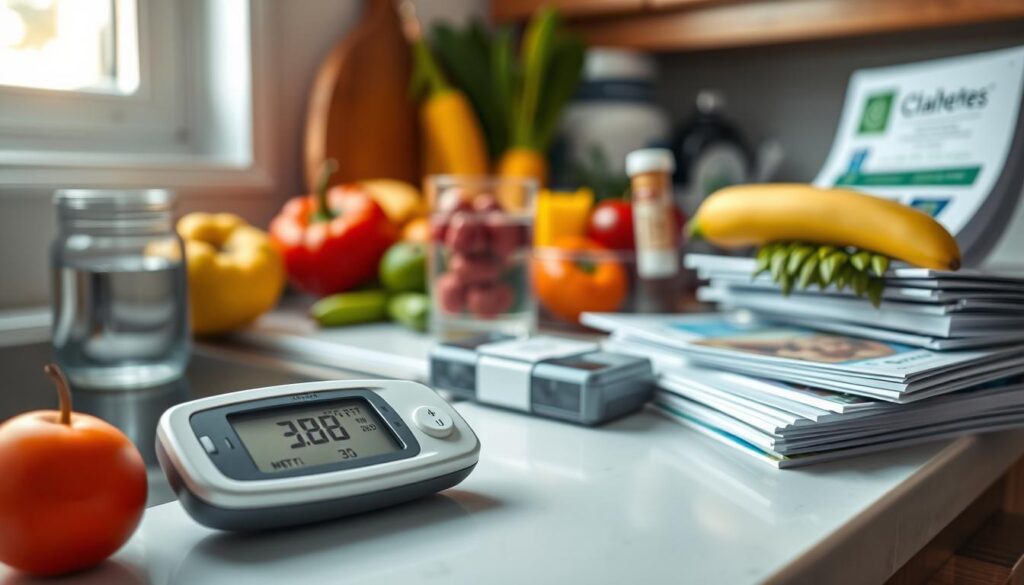
Another crucial aspect of diabetes management is portion control. By keeping portions regulated, you reduce the risks of overconsuming carbohydrates, which can affect blood sugar levels. Additionally, regular blood sugar monitoring is necessary to track how different foods impact your glucose levels.
To illustrate, here’s a comparison of low glycemic index (GI) foods versus high glycemic index foods:
| Low Glycemic Index Foods (GI) | High Glycemic Index Foods (GI) |
|---|---|
| Quinoa | White Bread |
| Lentils | Potatoes |
| Apples | Rice Cakes |
Before making any dietary changes, especially for rapid weight loss, it is imperative to consult with a healthcare provider. This ensures that any new diet aligns with your diabetes management plan, reducing the risk of adverse effects on blood sugar control. Following the guidelines of the American Diabetes Association and other clinical guidelines can help in tailoring a diet that is both safe and effective for managing diabetes while promoting weight loss.
Healthy Diet Plan for Weight Loss
Embarking on a healthy weight loss journey requires a meticulously planned diet that incorporates all essential nutrients while maintaining optimal hydration. A well-thought-out, nutrient-rich diet ensures that you are not just shedding those extra pounds but also staying healthy and energized throughout the process.
Essential Nutrients
A comprehensive weight loss nutrition plan must include a balanced array of vitamins, minerals, proteins, fats, and carbohydrates. Vitamins and minerals play crucial roles in various bodily functions and aid in fostering an efficient metabolism. Proteins are vital for muscle repair and growth, which can be beneficial when combined with exercise. Healthy fats, found in foods like avocados and nuts, offer essential fatty acids that support brain health and satiety. Carbohydrates should primarily come from complex sources like whole grains, fruits, and vegetables, ensuring steady energy levels throughout the day.
Hydration Tips
Proper hydration is a cornerstone of weight loss and overall health. Water intake & weight loss are closely linked, as water helps to regulate body temperature, lubricate joints, and flush out toxins. To maximize the benefits of a nutrient-rich diet, it’s imperative to stay well-hydrated. Aim to drink at least eight 8-ounce glasses of water a day, and increase intake if engaging in physical activities. Including water-rich foods like cucumbers and watermelons can also contribute to your hydration goals.
You may like to read: Magnesium deficiency back pain and scleroderma
| Nutrient | Function | Food Sources |
|---|---|---|
| Proteins | Muscle repair and growth | Lean meats, legumes, tofu |
| Healthy Fats | Brain health, satiety | Avocados, nuts, seeds |
| Carbohydrates | Energy | Whole grains, fruits, and vegetables |
| Vitamins & Minerals | Various bodily functions | Fruits, vegetables, dairy products |
Supplemental Exercise Routine
Incorporating an exercise for weight loss into your daily routine can significantly amplify the results from your diet plan. According to the World Health Organization, adults should engage in at least 150 minutes of moderate aerobic activity or 75 minutes of vigorous activity weekly, complemented by muscle-strengthening activities on two or more days per week.
A well-rounded fitness plan is key to achieving optimal weight loss. Various forms of physical activity cater to different fitness levels, ensuring there’s an option for everyone. Here are some recommended routines:
- For beginners: Start with brisk walking or light jogging for 30 minutes daily, paired with basic bodyweight exercises like squats and push-ups.
- For intermediate levels: Incorporate high-intensity interval training (HIIT) and moderate strength training sessions three times a week.
- For advanced levels: Combine strength training, HIIT, and endurance exercises like swimming or cycling for a more comprehensive workout regimen.
Combining strength training with cardiovascular exercises can boost your metabolism and enhance caloric burn. Exercise physiologists recommend balancing these two types of workouts for maximum effectiveness. Here’s a comparative look:
| Exercise Type | Benefits | Frequency |
|---|---|---|
| Cardio | Improves endurance, burns calories, and supports heart health | 3-5 times a week |
| Strength Training | Builds muscle, boosts metabolism, and strengthens bones | 2-3 times a week |
Fitness experts emphasize the importance of personalizing your workout regimen to suit your goals and physical capabilities. By integrating structured exercise routines into your lifestyle, you can achieve a well-balanced fitness regimen that enhances your weight loss efforts.
Conclusion
As we navigate through this journey of weight loss success, it is crucial to remember the valuable insights discussed across the article. We delved into the fundamental importance of a caloric deficit, the essentials of meal planning, and the power of selecting the right diet. Whether opting for a low-carb, keto, or balanced diet, the strategies remain centered on your well-being and sustainable health improvements.
Reflecting on this diet plan, it’s vital to set realistic expectations. Rapid weight loss may seem tempting, but nurturing a healthy lifestyle changes your perspective on long-term health. Engaging with stories from those who have succeeded and integrating psychological insights can bolster your adherence to these strategies. The ultimate goal, after all, is not just a quick drop in weight but a sustained, healthier version of yourself.
Reach out for support when needed and take pride in your progress, no matter how small. The path to a healthier you is not a sprint but a marathon, necessitating patience and self-care. Embrace the encouragement offered, and let it fuel your continued success. Here’s to making healthy lifestyle changes that will benefit you in the long run, paving the way for a brighter, healthier future.
You may like to read: Gut Healthy and Sustainable Eating Guide
